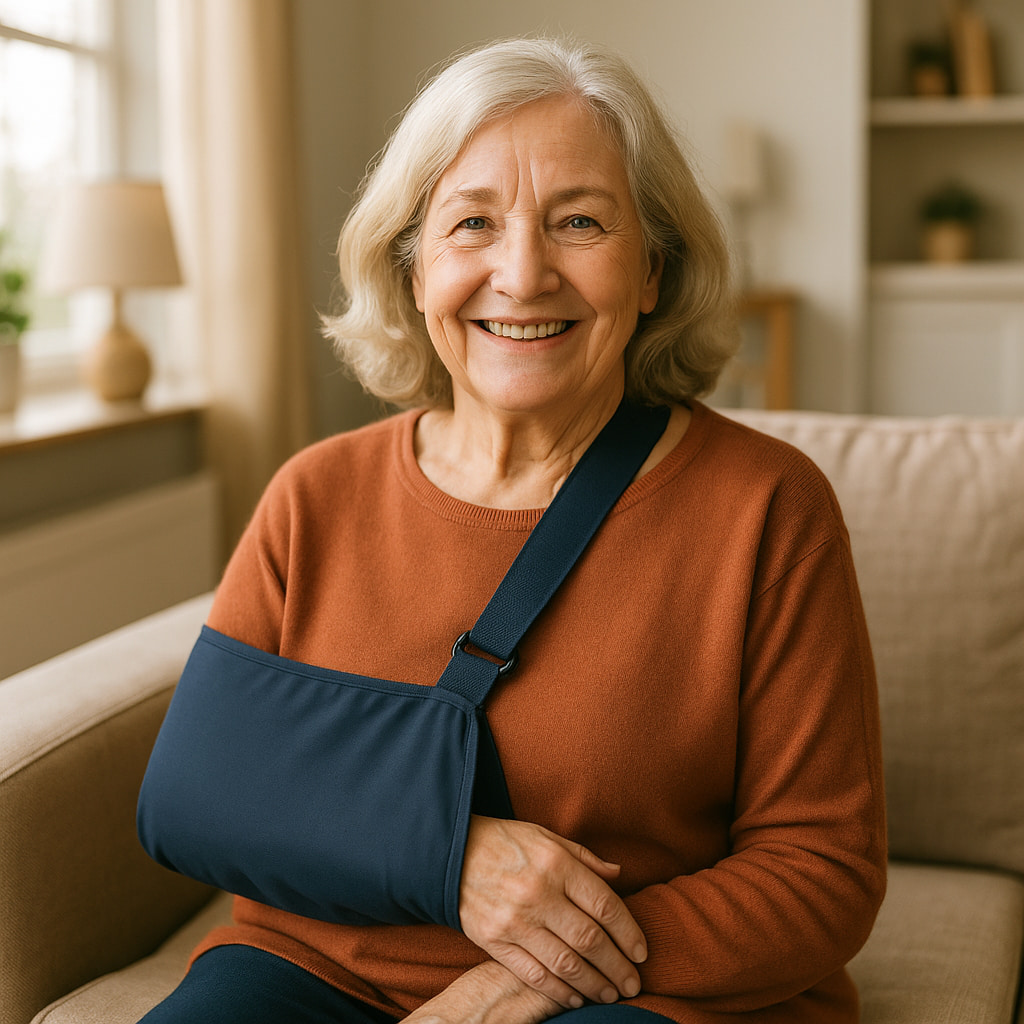See Also
Rehabilitation Goals
- Protect the surgical repair
- Reduce pain and inflammation
- Restore shoulder range of motion (ROM)
- Improve shoulder strength
- Restore functional activities of daily living (ADLs)
Expected Recovery Time
| Milestone | Timeframe |
|---|---|
| Sling use | 0-4 weeks (outdoors and at night, otherwise off) |
| Passive ROM | 0-6 weeks |
| Active ROM | 6-12 weeks |
| Light strengthening | 10-16 weeks |
| Functional activities | 4-6 months |
| Full recovery | 6-12 months |
Sling Instructions
- The sling is very important to use all day and night while any local anaesthetic wears off in the first 48-72 hours after surgery.
- After that point if you are comfortable you are encouraged not to wear a sling during the day to allow movement to begin
- Use the sling during sleep for the first 4 weeks in case of any abnormal movements
- If you can sleep and rest with a pillow placed behind your elbow to push it forward this is a safer position for dislocation risk than letting it fall back (rearward)
- For the first 4 weeks use the sling when travelling outdoors to let others know you have a sore shoulder
- Do not lift anything heavy (no more than 500g; e.g. a cup of tea or a can of soft drink) with or without the sling for the first 6 weeks
- Please note these instructions only apply to a Reverse Total Shoulder Replacement
- For sling instructions following an Anatomic Total Shoulder Replacement see here
Phase 1: Early Post-op (0-2 weeks)
Goals
- Protect surgical repair
- Manage pain and inflammation
- Prevent stiffness in nearby joints
- Educate patient on precautions and care
Instructions
- Wear the sling at all times except during exercises and hygiene
- Apply ice packs for 15-20 minutes several times a day to control swelling (ensure the temperature is above 0°C to prevent frostbite)
- Keep surgical wound clean and dry
- Avoid shoulder movements unless instructed
- No lifting, pushing, or pulling
Exercises
- Hand, wrist, and elbow range of motion exercises
- Gentle grip strengthening
- Pendulum exercises (small circles and back-and-forth swings)
- Scapular retraction exercises (gentle)
- Begin supervised passive range of motion (PROM) if approved by surgeon
Phase 2: Protected Passive Range of Motion (2-6 weeks)
Goals
- Begin gentle passive shoulder motion
- Maintain mobility of surrounding joints
- Control pain and swelling
Instructions
- Continue sling use except during exercises
- Avoid reaching behind your back or across your body
- Do not lift anything with the surgical arm
- Follow physiotherapist guidance for PROM exercises
Exercises
- Passive forward flexion (limited to surgeon’s ROM restrictions)
- Passive external rotation (usually limited to 30° initially)
- Continue elbow, wrist, and hand exercises
- Continue pendulum exercises
- Scapular retraction and stabilization exercises
Phase 3: Active-Assisted and Active Range of Motion (6-12 weeks)
Goals
- Transition from passive to active motion
- Gradually restore functional ROM
- Begin light muscle activation without resistance
Instructions
- Discontinue sling use as guided by the surgeon
- Avoid sudden or forceful shoulder movements
- Limit reaching and overhead activities
Exercises
- Active-assisted range of motion (AAROM): pulleys, cane exercises
- Progress to active ROM as tolerated
- Supine shoulder flexion and external rotation
- Scapular mobility and stabilization exercises
- Gentle isometric exercises (if approved)
Phase 4: Strengthening Phase (10-16 weeks)
Goals
- Improve shoulder and scapular strength
- Enhance stability and endurance
- Resume light functional tasks
Instructions
- Continue to avoid heavy lifting, pushing, or pulling
- Gradually introduce strengthening exercises under supervision
Exercises
- Light resistance band exercises (external rotation, internal rotation, rows)
- Scapular strengthening: retraction, protraction, depression
- Shoulder flexion and abduction with light weights
- Core and postural exercises
Phase 5: Functional and Advanced Strengthening (4-6 months and beyond)
Goals
- Maximize strength, ROM, and function
- Return to desired activities
Instructions
- Avoid high-impact activities and heavy lifting
- Continue home exercise program as advised
Exercises
- Progressive resistance training as tolerated
- Functional movement training (reaching, lifting light objects)
- Endurance exercises (walking, stationary cycling)
- Sport- or hobby-specific training if appropriate
When to Contact Your Surgeon
- Increased redness, swelling, or warmth around the incision
- Fever over 38°C
- Severe or worsening pain
- Numbness or tingling in the hand or arm
- Drainage from the surgical site
- Loss of shoulder movement that worsens
Disclaimer
This is a general guideline. Your physiotherapist or Dr Lambers may adjust the protocol based on your specific condition and progress.
